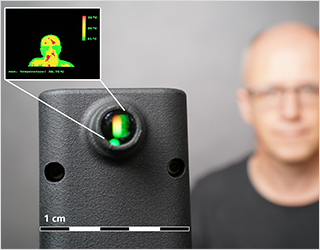12 | 2022 – Power-saving OLED microdisplays for body temperature screening via thermal imaging
After two years of development, the European Commission-funded project INNO4COV-19 (FKZ 101016203), which supported the commercialization of new products to combat COVID-19 in Europe, has come to an end. The Fraunhofer Institute for Organic Electronics, Electron Beam and Plasma Technology FEP developed, among other things, a prototype of a portable thermal camera system with integrated, low-power microdisplays for early and contactless detection of infected persons. This system will be presented at CES 2023 in Las Vegas, USA, January 5-8, 2023, at the Fraunhofer FEP booth, No. 55823, German Pavilion, in the Venetian Expo Center.
Thermal imaging cameras provide important information about differences in temperature in the vicinity. Depending on the application, they can, for example, visualize the body temperature of patients and visitors in hospitals from a distance or reveal problems with the thermal insulation of houses. Rapid and accurate temperature screening of elevated body temperatures, for example, can make an important contribution to the control of epidemics or pandemics and prevent the spread of infections at an early stage. The use of thermal imaging cameras to detect suspected cases is already an established method in public places, hospitals or train stations.
INNO4COV-19 for new products against COVID-19
The INNO4COV-19 project started at the height of the Corona pandemic in late 2020 and aimed to efficiently and rapidly commercialize new products to control the COVID-19 pandemic and its consequences, and to combat future pandemics. To this end, 11 partners from 7 European countries collaborated and established an open access platform. This provides the expertise, network and service to evaluate, develop, scale up and pilot produce innovative products and corresponding technologies related to COVID-19. In addition, within the project, another 30 companies from various fields ranging from medical technology, environmental monitoring systems, sensors to artificial intelligence and data mining were directly funded and made use of this established platform.
Within the project, Fraunhofer FEP developed electron beam technologies for the sterilization of textile materials on large surfaces and the corresponding microbiological verification. Furthermore, a portable system for continuous monitoring of body temperature for the earliest possible detection of infected persons was realized using OLED microdisplay technology.
Microdisplays for contactless temperature screening
The result is now a portable, handheld device with an integrated thermal camera. Developer Judith Baumgarten from Fraunhofer FEP explains the system: "We have drawn on our many years of know-how in OLED-on-silicon technology and IC design for this monitoring system for contactless temperature screening. The basis of the system is a tiny OLED microdisplay, which is extremely power-efficient due to its intelligent backplane architecture and is used to visualize the data. We combined the display with an infrared sensor to create a thermal imaging camera that both measures body temperature and displays the result directly via a near-to-eye visualization."
Using OLED microdisplay technology, extremely small components on the order of less than 3 × 2 cm² can be realized, which also feature a thickness of less than 5 mm including the control circuitry. The ultra-low power concept of the displays developed at Fraunhofer FEP also serves the prototype of the thermal camera system with an extremely low power consumption of less than 5 milliwatts.
The system converts the 2D information of the uncooled thermal camera into a color image, which is displayed on the ultra-low power microdisplay in a resolution of 320 × 240 pixels, with a display diagonal of 0.19 inches. A button can be used to set the displayed temperature range in one-hand operation.
Power-saving wearables also for industry or the fire department
In addition to its use for monitoring the temperature of patients and individuals in pandemic events, the development can also be put to good use in other areas in the future. The core components of the system can be easily embedded in lightweight smart glasses, headgear, caps, personal face shields or protective equipment. Applications in disaster relief, firefighting or even troubleshooting in industrial plants benefit here from the power-saving displays and thus long battery life. For use in bright environments and in direct sunlight, the microdisplay system offers high luminance levels of up to 5000 cd/m².
The resulting thermal camera system will be presented at CES 2023 in Las Vegas, January 5 – 8, 2023, at the Fraunhofer FEP booth, No. 55823 at the German Pavilion. Fraunhofer FEP developers will be available for discussions and talks on the integration and further development of the technology and will also provide an overview about possible evaluation kits for testing.
About INNO4COV-19:
This project has received funding from the European Union’s Horizon 2020 Research and Innovation Programme.
Funding reference: 101016203
Duration: 01.10.2020 – 30.09.2022
Fraunhofer FEP at CES 2023
5. – 8. January 2023
German Pavilion, Booth No. 55823
Venetian Expo, LEVEL 2, Hall D
http://ces-lasvegas.german-pavilion.com
 Fraunhofer Institute for Electron Beam
Fraunhofer Institute for Electron Beam